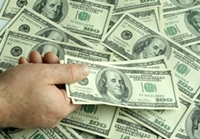
- HOME
- ABOUT
- PRODUCT & SOLUTIONS
- NEWS
- CAREERS
- SUPPORT
-
News
BACK TO LIST More phony $100 bills: Watermark can foil bogus bill makers
2005-08-01

The origin of the fake $100 bills circulating Winona is unknown to police, but they said whoever created them did a good job.
The bills appear convincing until you hold them up to the light, police said. To the right of the $100 bill’s Benjamin Franklin is a watermarked image of the $5 bill’s Abraham Lincoln.
This means the fakers are washing, or bleaching, ink from original $5 notes and printing high quality $100 bill images on original $5 treasury paper, police said Thursday.
"We just want to make it known to people that (the bills) are very good," said Paul Bostrack, deputy chief.
The typical safeguard used by cashiers and clerks, a marker pen that shows the bill is on fake stock, won’t work on these, he said.
Police announced yet another counterfeit $100 bill, this one turning up Wednesday at Winona National Bank’s West Broadway building, passed at a Winona business on Tuesday. This is the sixth one reported in a week in Winona.
John McCullough, executive director of the Retailers Protection Association in Minnesota, said the method used to make the Winona bills is not common.
"This is fairly new," he said. "We saw it about five years ago, a case, but that was a traveling group."
Similar counterfeit bills are showing up in Wisconsin, McCullough said.
"I would guess it’s a strong possibility it’s the same group," he said. "They’ll try to come through town, particularly during vacation seasons, and lay this fraud down before anybody can pick up on it, and quite frankly that’s why small towns are often hit the hardest."
Counterfeiters often scan money with computer equipment and print new money on non-treasury paper. Police Chief Frank Pomeroy said this has been the source of Winona’s counterfeit bills in the last few years.
"These are good," he said of the recent money.
McCullough said computer printers create much less convincing bills.
"The paper is really tough to get right," he said. "The feel isn’t right, it tears. It’s very tough to replicate the texture of a real bill."
According to the U.S. Secret Service, $47.5 million in counterfeit money was discovered in circulation in 2002. Of this amount, 39 percent was computer generated, compared with only 0.5 percent of the counterfeit currency seized in 1995.
According to Winona Police, the other fake $100 bills are two passed April 27 at ShopKo, one passed last week at Target and two detected Monday at Kmart.
Because of frequent handling, it is nearly impossible to pull perpetrators’ fingerprints from the bills, Bostrack said.
John Kirkwood, special agent in charge of the U.S. Secret Service office in Minneapolis, said bills similar to those circulating in Winona have turned up elsewhere in the state recently and are called "bleached notes."
"It’s a time consuming way of counterfeiting," Kirkwood said.
It’s also risky. The maximum penalty for making and circulating counterfeit bills is 15 years in prison, he said.
There is a "pretty good chance" the bills were made by the same source, Kirkwood said. The best way to detect a counterfeit is to compare a suspect bill with a known genuine note, he said.
While most people believe the Secret Service’s sole charge is protecting presidents, its original role was rooting out counterfeits, Kirkwood said.
The service was created in 1865 at the end of the Civil War, when up to a third of all currency in circulation was counterfeit, Kirkwood said. It was only after President William McKinley was shot in 1901 that the Secret Service took on the more familiar mission of guarding top government officials, he said.
The Secret Service was part of the Department of Treasury until two years ago, when it was moved to Homeland Security, Kirkwood said.
Reporter Jeff Dankert can be reached at (507) 453-3513, or e-mail: jdankert@winonadailynews.com.
